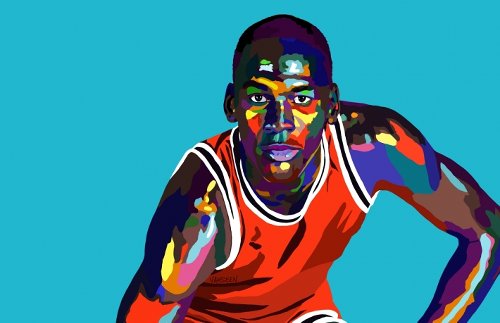By Sandali Handagama
First published – Apr 5, 2021
NFTs are opening the typically exclusive art world to artists from diverse backgrounds, and are helping those artists monetize their work.
On March 12, Vakseen, a 41-year-old digital artist based in California, accepted an 8 ETH bid (around $16,800 as of Monday) for the first of six editions of a digital painting featuring legendary basketball player Michael Jordan.
The exposure from the sale of the painting, which was minted as a non-fungible token (NFT), led to Vakseen being commissioned for another digital art piece. At the time of publication, the third edition of the Michael Jordan painting is priced at 9 ETH (around $18,900) and bidding is ongoing.
Vakseen’s art was also on display at a NFT exhibition featuring Black artists from around the world. The exhibition, titled “Harmony & Balance,” mimicked a digital art museum and was created to support the Black NFT artist community. It featured over 100 digital art pieces by 30 Black artists, including Vakseen. The art featured in the exhibition was worth a total of around $500,000.
“There are so many hurdles and obstacles involved with gaining any sort of recognition within the art world as a Black man, as a man of color or as any person of color. The NFT space is changing that and the exhibition is giving us an opportunity to be seen,” Vakseen told CoinDesk.
Some Black artists told CoinDesk that, in addition to helping them independently monetize their work, the recent popularity of NFTs is opening up the typically exclusive art world to artists from diverse backgrounds.
Art minted as NFTs exploded in 2021, leading to digital artist Beeple selling an NFT art piece for $69.3 million in early March. Since the sale, more artists from around the world have begun minting their work as NFTs for sale via a range of platforms including OpenSea, Rarible, Mintable and Makersplace.
A number of initiatives geared towards amplifying Black artists in the digital space have come to life in the last year, including a Black NFT art club on social media platform Clubhouse to showcase Black artists, as well as the digital art gallery ONE/OFF, currently featuring 33 Black crypto artists.
According to data provided by ONE/OFF to Cuy Sheffield, head of crypto at Visa, between January and November 2020 just 58 Black crypto artists sold “a combined 513 pieces of crypto artwork for 1,132 ETH (total market value of $736,000).”
In the first two days after launching on March 27, the “Harmony & Balance” exhibition sold around 10 art pieces, one of which was valued at $4,000.
These efforts are still small compared to the multibillion-dollar global art auction market, but Isaiah Jackson, author of “Bitcoin Black America” and host of “Community Crypto” on CoinDesk TV, believes it’s only getting started.
“The Black NFT art space has opened up a new world where crypto and creative minds come together … This is just the beginning, and I believe the Black creative community will be the leaders in the space for years to come,” Jackson said.
Removing gatekeepers
In 2018, artwork by Black artists accounted for just 1.2% of the global art auction market.
Even as NFTs were taking off in 2021, Seyi Awotunde, U.K.-based entrepreneur and creator of the “Harmony & Balance” NFT exhibition, felt that talented Black artists were still not getting the attention they deserve.
“First I looked at Christie’s, which sold Beeple, and I thought, why can’t that be a Black artist to go on? There are so many incredibly gifted Black artists in their own right. There didn’t seem to be a great platform for them right now so I thought, why not go do it ourselves,” Awotunde told CoinDesk.
Awotunde began scouting for Black NFT artists to feature in the exhibition. One artist, 28-year-old Andre OShea, minted his first NFT artworks in October as a test run but never actually advertised or sold them. He minted another in February, which took 18 days to sell. But since then, thanks in part to advertising and the new popularity of NFTs, he sold three pieces ranging from 0.07-0.3 ETH ($150- $600) within 24 hours in March.
“As a Black artist, NFTs mean leveling the playing field and taking the keys away from traditional gatekeepers in the art world. It is also a way for me to uplift my community through creativity,” OShea told CoinDesk via an email.
Awotunde also met 24-year-old Canadian-Nigerian multimedia artist Lizzy Aroloye on Clubhouse because she asked questions on information forums about how to set up her own NFT. Aroloye reached out to him a few days later saying she’d already sold her first artwork; she was invited to join the exhibition.
Vakseen, familiar with the NFT world, was first scouted by NFT platform Makersplace to mint his art back in 2018. But Aroloye was new to the space and minted a collection of her art NFTs as recently as March 5. In under 24 hours she had sold one for 2.5 ETH (now around $5,000).
“Obviously, not everyone has this experience right off the bat but it gave me this reassurance that this is our space, and if we continue to do the work that we’ve always been doing this can be such a game changer,” Aroloye told CoinDesk.
After the exhibition sold 10 art pieces within the first two days, Awotunde decided to extend the show until April 4.
Source: Coindesk.com










